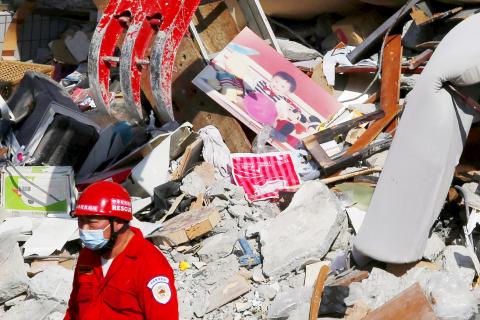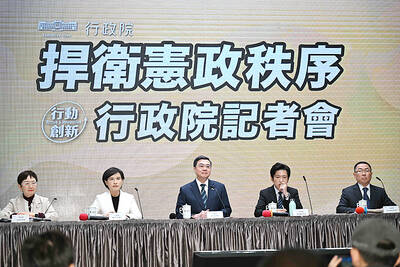The Tainan District Prosecutors’ Office yesterday sent a team of four prosecutors to inspect the ruins of the Weiguan Jinlong building in Tainan’s Yongkang District (永康) to investigate allegations of shoddy workmanship that may have caused its collapse in Saturday’s earthquake.
The bulk of the complex was left lying on its side after the magnitude 6.4 earthquake hit southern Taiwan at 3:57am on Saturday, and it has been the site of most of the casualties from the temblor.
An unknown number of people were believed to be still trapped in the rubble and rescue operations were ongoing at press time last night.

Photo: Tyrone Siu, Reuters
Advisers from the Tainan Civil Engineers’ Association volunteered to help at the site to provide rescue workers with their expertise to facilitate the use of equipment.
Government records show that a construction license was issued 1992 and building was completed in 1994.
The complex was built by the now-defunct Weiguan Construction Co (維冠建設公司), Construction and Planning Agency Director-General Hsu Wun-long (許文龍) said.
Minister of the Interior Chen Wei-zen (陳威仁) said a full legal investigation would be launched after the conclusion of rescue operations to find if anyone was to blame for the disaster.
Tainan Mayor William Lai (賴清德) said in a Facebook post that the city government is helping the prosecutors in their investigation, and that three engineering associations had agreed to help evaluate articles of evidentiary value and keep the items safe.
If and when prosecutors file charges, “the city government will be at the side of its residents and protect the public interest,” he said.
The city government has prioritized compensation to families affected by the disaster in handling the donations that have been pouring in, and some money has already been distributed, he said.
Sources have said Lee Ming-hui (李明輝) was the owner of Weiguang Construction at the time the complex was built. He reportedly has a reputation in the construction industry for being able to obtain contracts, but also for his controversial managerial style.
The quality of Lee’s construction projects has been called into question following the collapse of the Weiguan Jinlong building and the discovery of empty cans in its cracked pillars.
Building residents were quoted by the Chinese-language Apple Daily as saying that during the quake, the building rocked “up and down” and then began to sway “left and right” before the collapse, raising suspicion that the building’s short sides and height meant it lacked the necessary depth to provide adequate support for its weight in a quake.
They said the collapse appears to have begun at the building’s arcade, which contained a smaller number of pillars and struts than the rest of the building.
Tainan Civil Engineers’ Association director-general Cheng Ming-chang (鄭明昌) said the 21-year-old building’s arcade on the east side appeared to have contained fewer struts, pillars and walls than needed for structural support during a quake.
The hollowed-out ground floor of the building is reminiscent of several buildings that collapsed during the 921 Earthquake in 1999.
The mother of one of the injured residents was quoted by Reuters as saying that residents had long complained of many problems such as tiles falling from walls, malfunctioning elevators and blocked pipes.
Additional reporting by Reuters

The US government has signed defense cooperation agreements with Japan and the Philippines to boost the deterrence capabilities of countries in the first island chain, a report by the National Security Bureau (NSB) showed. The main countries on the first island chain include the two nations and Taiwan. The bureau is to present the report at a meeting of the legislature’s Foreign Affairs and National Defense Committee tomorrow. The US military has deployed Typhon missile systems to Japan’s Yamaguchi Prefecture and Zambales province in the Philippines during their joint military exercises. It has also installed NMESIS anti-ship systems in Japan’s Okinawa

‘WIN-WIN’: The Philippines, and central and eastern European countries are important potential drone cooperation partners, Minister of Foreign Affairs Lin Chia-lung said Minister of Foreign Affairs Lin Chia-lung (林佳龍) in an interview published yesterday confirmed that there are joint ventures between Taiwan and Poland in the drone industry. Lin made the remark in an exclusive interview with the Chinese-language Liberty Times (the Taipei Times’ sister paper). The government-backed Taiwan Excellence Drone International Business Opportunities Alliance and the Polish Chamber of Unmanned Systems on Wednesday last week signed a memorandum of understanding in Poland to develop a “non-China” supply chain for drones and work together on key technologies. Asked if Taiwan prioritized Poland among central and eastern European countries in drone collaboration, Lin

NO CONFIDENCE MOTION? The premier said that being toppled by the legislature for defending the Constitution would be a democratic badge of honor for him Premier Cho Jung-tai (卓榮泰) yesterday announced that the Cabinet would not countersign the amendments to the local revenue-sharing law passed by the Legislative Yuan last month. Cho said the decision not to countersign the amendments to the Act Governing the Allocation of Government Revenues and Expenditures (財政收支劃分法) was made in accordance with the Constitution. “The decision aims to safeguard our Constitution,” he said. The Constitution stipulates the president shall, in accordance with law, promulgate laws and issue mandates with the countersignature of the head of the Executive Yuan, or with the countersignatures of both the head of the Executive Yuan and ministers or

CABINET APPROVAL: People seeking assisted reproduction must be assessed to determine whether they would be adequate parents, the planned changes say Proposed amendments to the Assisted Reproduction Act (人工生殖法) advanced yesterday by the Executive Yuan would grant married lesbian couples and single women access to legal assisted reproductive services. The proposed revisions are “based on the fundamental principle of respecting women’s reproductive autonomy,” Cabinet spokesperson Michelle Lee (李慧芝) quoted Vice Premier Cheng Li-chiun (鄭麗君), who presided over a Cabinet meeting earlier yesterday, as saying at the briefing. The draft amendment would be submitted to the legislature for review. The Ministry of Health and Welfare, which proposed the amendments, said that experts on children’s rights, gender equality, law and medicine attended cross-disciplinary meetings, adding that